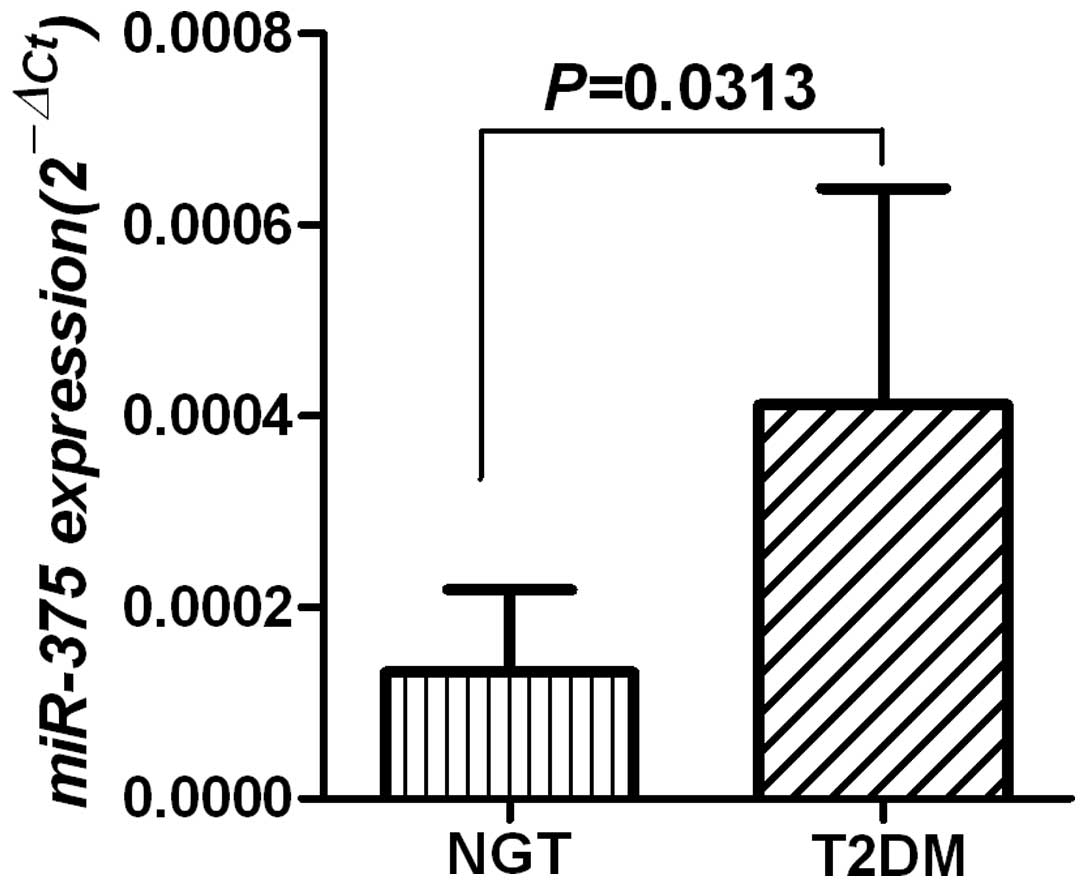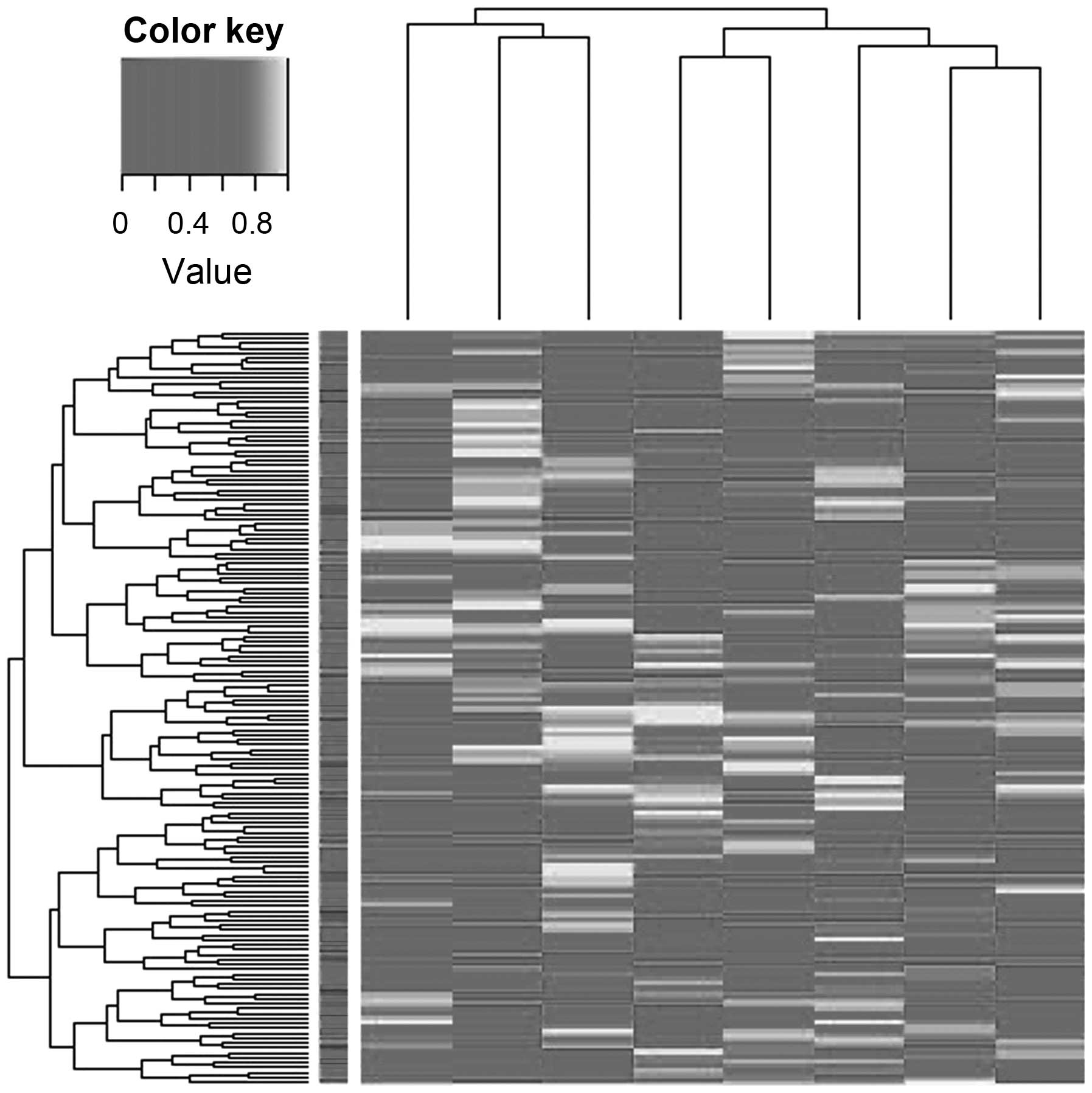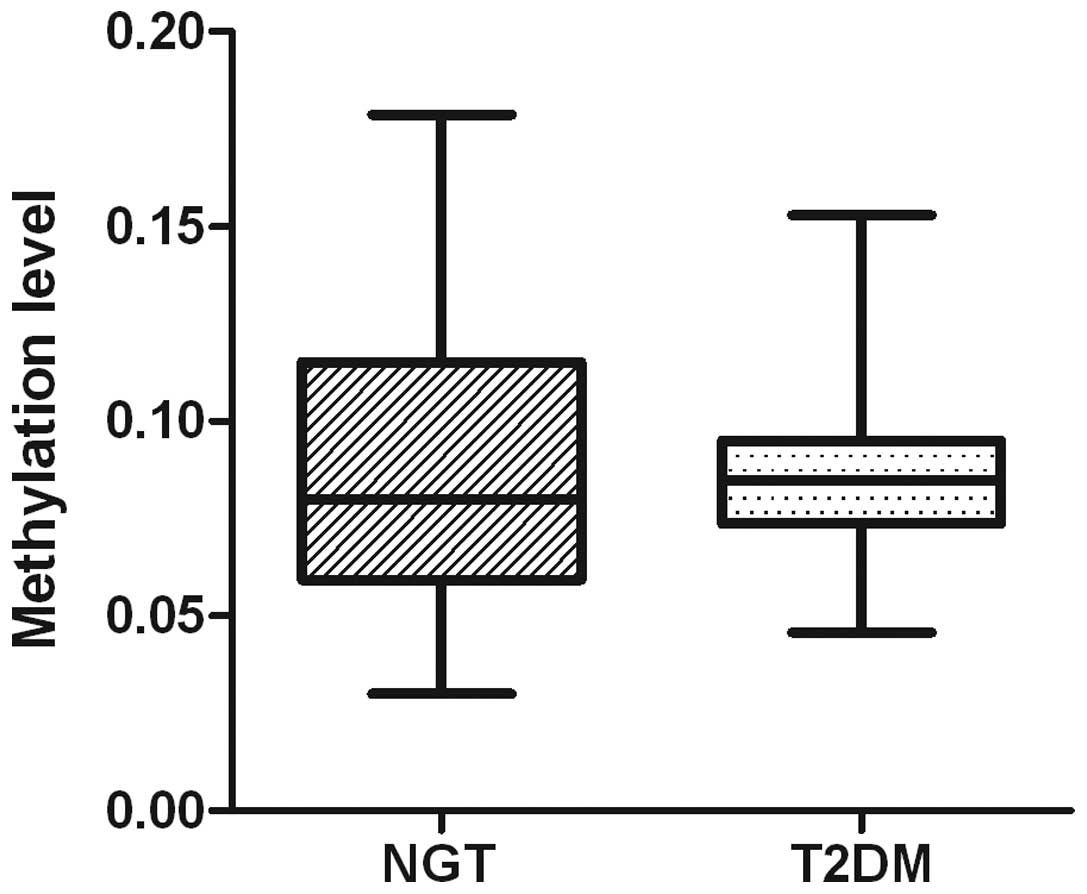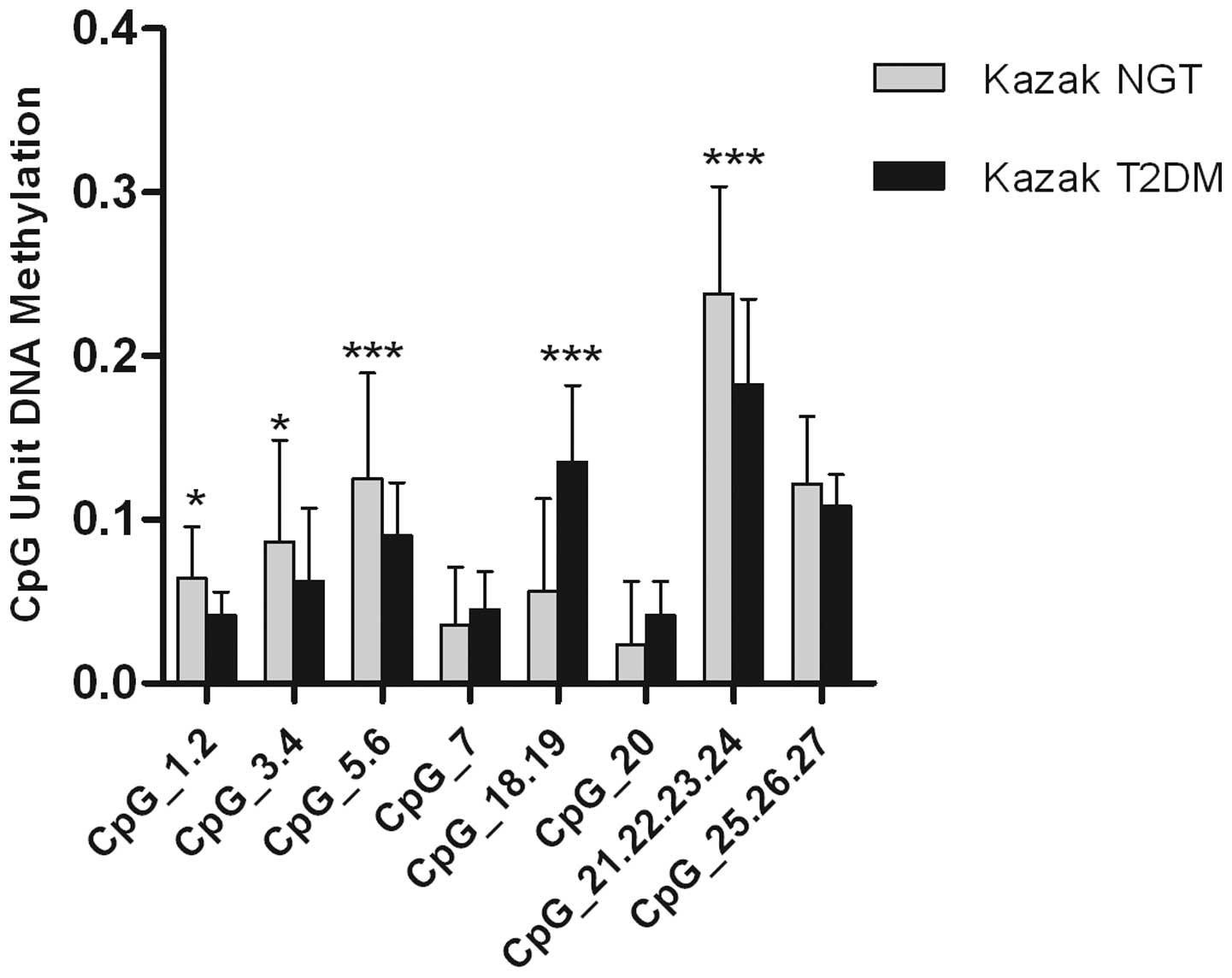Expression and DNA methylation status of microRNA-375 in patients with type 2 diabetes mellitus
- Authors:
- Published online on: December 18, 2013 https://doi.org/10.3892/mmr.2013.1872
- Pages: 967-972
Abstract
Introduction
Type 2 diabetes mellitus (T2DM) is a complex polygenic disease, commonly resulting from defects in insulin secretion and diminished sensitivity of target tissues to insulin (1). β-cell dysfunction is a fundamental characteristic of T2DM development, and it leads to quantitative and qualitative abnormalities in insulin secretion, abnormalities in the kinetics of insulin secretion and progression of the defects with time (2).
MicroRNAs (miRNAs) are endogenous small non-coding RNAs (~22 nucleotides), which are involved in post-transcriptional control of gene expression (3). They directly control the expression of a large portion of the human genome and are involved in the regulation of major cellular activities, including metabolism, differentiation, proliferation and apoptosis (4,5). miRNAs have been suggested to have a role in multiple human diseases (6) and increasing evidence has shown that miRNAs are also involved in the pathogenesis of metabolic diseases, including diabetes mellitus. Previous studies have revealed that miRNAs, including miR-375, miR-9 and miR-124a, are important regulators of specialized β-cell functions (7–10). It has been shown that miR-375, a pancreatic islet-specific miRNA, regulates insulin secretion through direct inhibition of insulin exocytosis (7). High levels of miR-375 are found in the pancreatic islet of obese (ob/ob) mice and have been shown to regulate glucose homeostasis (8). One study demonstrated that upregulated pancreatic miR-375 is a useful biomarker for pathways in the pathogenesis of T2DM associated with islet amyloid deposition and β-cell deficit (11). These findings suggest that miR-375 regulates the function of β cells in T2DM, but the exact role of miRNA-375 in T2DM has yet to be elucidated.
Previous studies have also investigated the role of epigenetics in the pathogenesis of T2DM (12,13). Epigenetic modifications, particularly DNA hypermethylation, have been found to have a role in the regulation of genes important for protection against T2DM. miR-375 is encoded in the intergenic region and has an independent promoter containing CpG islands, which provides a basis for the regulation of its expression by methylation. Therefore, it was hypothesized that aberrant methylation of the human miR-375 promoter may lead to abnormal expression, thereby causing β-cell dysfunction, and ultimately participate in the pathogenesis of the T2DM. This has already been previously demonstrated in certain types of cancer (14–16).
In China, the Kazak population has a significantly higher proportion of overweight individuals and a higher incidence of insulin resistance and hypertension compared with the Han population (17). Furthermore, the Kazak population are known to consume more meat and fewer vegetables than the Han population. However, the prevalence of T2DM in the Kazak population is only 3.65%, which is lower compared with the Han population in the same region (17). This suggests that the Kazak population may have a unique genetic background, and was the basis for the investigations in this study. It was hypothesized that the expression level and CpG methylation status of miR-375 may be important in the incidence and severity of T2DM. The changes in miR-375 expression level and the quantitative methylation status of CpG within the miR-375 promoter were assessed to determine whether aberrant promoter methylation of miR-375 was present in patients with T2DM. The findings may lead to the identification of a novel biomarker for the diagnosis of T2DM.
Materials and methods
Subjects
This study was prospectively performed and approved by the Institutional Ethics Committees of the First Affiliated Hospital of Shihezi University School of Medicine (Shihezi, Xinjiang, China) and conducted in accordance with the ethical guidelines of the Declaration of Helsinki. Written informed consent was obtained from all individuals prior to the start of the study. Individuals of Chinese Kazak origin with T2DM (n=100) and healthy controls with normal glucose tolerance (NGT; n=100) were recruited from the Department of Endocrinology and Metabolism at the First Affiliated Hospital of Shihezi University School of Medicine between 2010 and 2011. Diagnosis of T2DM was based on the World Health Organization criteria as fasting glucose levels ≥7 mmol/l (126 mg/dl), 2 h oral glucose tolerance test glucose levels ≥11.1 mmol/l (200 mg/dl) or clinical diagnosis of the disease. Patients with T2DM (54 male and 46 female; mean age, 51.33±11.75 years) were recruited when they were hospitalized for treatment for poor glycemic control. Individuals who came for a health checkup in the hospital were recruited as healthy controls (44 male and 56 female; mean age, 48.55±12.41 years). Any individuals who may have had an infectious disease prior to or during the recruitment were excluded from this study, as well as patients with autoimmune diseases.
Nucleic acid isolation
RNAs were isolated from peripheral plasma samples from patients with T2DM and controls with NGT using the miRNeasy Mini kit 50 (Qiagen, Hilden, Germany) and genomic DNA was isolated from peripheral plasma using the DNeasy Blood and Tissue kit (Qiagen) in accordance with the manufacturer’s instructions. The RNA and DNA were quantified by measuring their absorption at 260 nm (Toption Instrument Co., Ltd., Xi’an, China).
Reverse transcription and quantitative polymerase chain reaction (qPCR)
The TaqMan® microRNA Reverse Transcription kit (Applied Biosystems®, Foster City, CA, USA) was used for complementary DNA synthesis. For reverse transcription, 10 μl TaqMan Universal PCR Master Mix (Applied Biosystems) and 5 μl total RNA were reverse transcribed at 16ºC for 30 min, 42ºC for 30 min, and 85ºC for 5 min. miR-375 expression was quantified in triplicate using qPCR using the ABI Prism 7300 Sequence Detection System (Applied Biosystems). Taqman primers and probes for the target gene miR-375 and the internal control miRNA-16, which is often used as a normalization control for microRNAs, were obtained from Applied Biosystems. PCR was performed under the following conditions: 50ºC for 2 min then 95ºC for 10 min, followed by 40 cycles at 95ºC for 15 sec and 60ºC for 1 min. miRNA-16 was used as an internal control to normalize the expression level of each sample. The comparative threshold cycle (Ct) method was used to evaluate the relative abundance of miR-16 compared with U6 expression (fold changes relative to miRNA-16).
Analysis of methylation
To quantify the levels of methylation of the CpG islands in the miR-375 promoter, the high-throughput MassARRAY platform (Sequenom Inc., San Diego, CA, USA) was used as previously described (18). Briefly, bisulfite-treated DNA was amplified using primers for the miR-375 CpG island. The primers were designed using EpiDesigner (Sequenom Inc.) and were as follows: forward 5′-aggaagagagGGGTGGAGTATTTTTGTTTGTTG-3′ and reverse 5′-cagtaatacgactcactatagggagaaggct AAAAACATAATCCAAAACATCCT AAT-3′. The PCR products were spotted on a 384-pad SpectroCHIP (Sequenom Inc.), followed by spectral acquisition on a MassARRAY Analyzer. Methylation data of the individual units (1–3 CpG sites/unit) were generated using the EpiTyper version 1.0.5 software (Sequenom Inc.).
Statistical analysis
The differences in miR-375 CpG methylation between patients with T2DM and controls with NGT were assessed using the Mann-Whitney and Kruskal-Wallis tests. The distances between CpG methylation sites to transcription start sites were calculated using the RMySQL package and the SQL database version of the University of California Santa Cruz (UCSC) genome browser (http://genome.ucsc.edu/cgi-bin/hgGateway). Two-dimensional clustering was performed with the heatmap.2 function in the gregmisc package using the R statistical environment. Classical multidimensional scaling was performed using the cmdscale function and visualization was conducted through the scatter plot3d function in the gregmisc package. A Student’s t-test, a Wilcox test or a Fisher’s exact test was utilized to compare the qPCR results in different groups with standard function in R statistical environment. P<0.05 was considered to indicate a statistically significant difference.
Results
Characteristics of the subjects
A total of 100 patients with T2DM and 100 age-matched healthy controls with NGT participated in this study. The clinical characteristics of the subjects are shown in Table I. The average age was 51.33±11.75 years for patients with T2DM and 48.55±12.41 years for controls with NGT. As expected, the patients with T2DM had a higher body mass index (BMI), waist-to-hip ratio (WHR), systolic blood pressure (SBP), fasting plasma glucose (FPG), low-density lipoprotein cholesterol (LDL-C), total cholesterol (TC) and triglyceride (TG) and lower high-density lipoprotein cholesterol (HDL-cholesterol) compared with controls with NGT.
Upregulation of miR-375 expression in patients with T2DM compared with controls with NGT
It has previously been demonstrated that miR-375 expression is lost in different types of cancer (15,16); therefore it was investigated in this study whether aberrant expression of miR-375 was present in the patients with T2DM. qPCR was performed to determine the expression levels of miR-375 mRNA in T2DM plasma samples and corresponding NGT samples. As shown in Fig. 1, the level of miR-375 mRNA was significantly upregulated in T2DM samples compared with the NGT samples (P=0.0313).
Specific CpG hypomethylation of the miR-375 promoter may contribute to its overexpression in patients with T2DM
In order to understand the mechanism of miR-375 upregulation, the methylation status of the promoter region of miR-375 was investigated. To determine whether the methylation status was correlated with the upregulation of miR-375, T2DM and corresponding NGT samples were analyzed using MassARRAY EpiTyper. Hierarchical clustering identified substantial differences in the quantitative methylation profiling of T2DM samples compared with controls (Fig. 2).
A schematic representation of the promoter region of miR-375 according to UCSC Genome Browser’s CpG island annotations and miRbase release 13.0 is shown in Fig. 3. Methylation was present from −990 to −1,258 bp relative to the transcription start site of miR-375 in T2DM samples. Eight CpG units (comprising a total of 17 CpG sites) spanning 267 bp in the specified promoter region of miR-375 were analyzed in 100 T2DM samples and 100 controls (a total of 31,248 sites in all analyzed samples). The overall methylation of the miR-375 promoter was found to be <10% for the T2DM and NGT samples; the mean levels of miR-375 methylation, calculated from the methylation levels of the 17 CpG residues, were 8.59% in the patients with T2DM and 8.97% in the control group with NGT (P=0.9582; Fig. 4). The levels of miR-375 promoter methylation varied between 4.6 and 15.3% in T2DM samples and between 3.0 and 17.9% in NGT samples.
Although no differences in overall methylation levels between control and T2DM samples were observed, hypomethylation of specific critical CpG units was investigated to determine whether they accounted for the increased miR-375 expression observed in T2DM samples. Analysis of the individual CpG units in T2DM samples and controls using MassARRAY EpiTyper revealed that six CpG units in this amplicon were hypomethylated, with the exception of CpG_7 and CpG_20. In addition, significant differences were observed in four specific CpG units, CpG_1.2, CpG_3.4, CpG_5.6 and CpG_21.22.23.34, which were hypomethylated in T2DM samples but not in NGT samples (Fig. 5).
Discussion
Previous studies have shown that expression levels of miR-375 have different effects in different types of cancer. For example, the upregulation of miR-375 stimulates cell proliferation in breast and prostate cancer (14,19); however, downregulation of miR-375 in gastric cancer leads to the activation of the phosphoinositide-dependent kinase 1-Akt (PDK1-Akt) and Janus kinase (JAK) oncogenic pathways (15,20). In this study, the expression pattern of miR-375 was investigated in patients with T2DM. It was found that the plasma level of miR-375 was significantly upregulated in T2DM samples compared with NGT samples (Fig. 1). It has previously been shown that overexpression of miR-375 downregulates the expression of myotrophin, a pivotal factor implicated in the regulation of a variety of genes responsible for cellular apoptosis and proliferation (21). Together, these observations suggest that miR-375 is involved in the pathogenesis of T2DM. Since plasma/serum miRNA levels are particularly stable, and the expression level of miRNAs in the serum is reproducible and consistent among individuals, a previous study investigated the presence of circulating miRNAs and their potential use as disease biomarkers (22). The results of the present study suggest that the plasma level of miR-375 may allow patients with T2DM to be distinguished from healthy controls, and, therefore, miR-375 may be used as a novel biomarker for T2DM.
Epigenetic modifications of DNA, such as methylation, have been suggested to have a key role in T2DM disease progression (12,13), and miRNA are epigenetically regulated by DNA methylation (23). Several studies had revealed that the expression of miR-375 is epigenetically regulated in oesophageal squamous cell carcinoma, as well as gastric and breast cancer (14–16); however, miR-375 promoter methylation has not been directly linked to T2DM. In the present study, it was investigated whether the upregulation of miR-375 was mediated by epigenetic mechanisms in patients with T2DM. Using MALDI-TOF MS, methylation patterns were evaluated at multiple CpG sites within the promoter regions of miR-375, and it was found that overall there was less methylation in T2DM samples compared with NGT samples, although this difference was not statistically significant (P>0.05) (Fig. 4). Since there is considerable variation between methylation levels of different CpG units, the methylation status of specific CpG units was further evaluated. The results revealed that there was a significant decrease in methylation in four specific CpG units in T2DM samples compared with NGT samples. These findings suggest that miR-375 CpG island hypomethylation may be negatively correlated with miR-375 expression. In addition, hypomethylation of miR-375 may be used to predict the progression of T2DM. miR-375 inhibits insulin secretion and decreases the number of β cells. miR-375 may also affect cell proliferation, differentiation and the expression of apoptosis-associated genes so as to promote the occurrence of apoptosis(15,16). Therefore, it was hypothesized that hypomethylation of the miR-375 gene promoter may be involved in the development of diabetes.
In this study, aberrant miR-375 expression and methylation were detected in the plasma of patients with T2DM. This has a potential clinical application for the identification of pateints with T2DM from individuals with NGT. Despite the small sample size, this is the first study, to the best of our knowledge, to report an alteration in the level of miR-375 in plasma of patients with T2DM. Clinical detection of upregulated miR-375 levels may not be limited to using plasma for T2DM diagnosis, and it may be interesting to investigate whether miR-375 is also present in other body fluids, for example saliva or urine, in order to establish a general diagnostic method.
In conclusion, it was demonstrated in this study that miR-375 expression was significantly upregulated and hypomethylation was found in four specific CpG units of the miR-375 promoter in patients with T2DM compared with controls with NGT. These results suggest that DNA methylation may have an important role in the control of T2DM. These results may also lead to the development of miRNA-based targeted approaches for the treatment of T2DM.
Acknowledgements
This study was supported by the National Natural Science Foundation of China (81060065/H0711).
References
|
Butler AE, Janson J, Bonner-Weir S, Ritzel R, Rizza RA and Butler PC: Beta-cell deficit and increased beta-cell apoptosis in humans with type 2 diabetes. Diabetes. 52:102–110. 2003. View Article : Google Scholar : PubMed/NCBI | |
|
Guillausseau PJ, Meas T, Virally M, Laloi-Michelin M, Médeau V and Kevorkian JP: Abnormalities in insulin secretion in type 2 diabetes mellitus. Diabetes Metab. 34(Suppl 2): S43–S48. 2008. View Article : Google Scholar : PubMed/NCBI | |
|
Ambros V: The functions of animal microRNAs. Nature. 431:350–355. 2004. View Article : Google Scholar : PubMed/NCBI | |
|
Bartel DP: MicroRNAs: target recognition and regulatory functions. Cell. 136:215–233. 2009. View Article : Google Scholar : PubMed/NCBI | |
|
Uhlmann S, Zhang JD, Schwäger A, Mannsperger H, Riazalhosseini Y, Burmester S, et al: miR-200bc/429 cluster targets PLCgamma1 and differentially regulates proliferation and EGF-driven invasion than miR-200a/141 in breast cancer. Oncogene. 29:4297–4306. 2010. View Article : Google Scholar : PubMed/NCBI | |
|
Chang TC and Mendell JT: microRNAs in vertebrate physiology and human disease. Annu Rev Genomics Hum Genet. 8:215–239. 2007. View Article : Google Scholar : PubMed/NCBI | |
|
Poy MN, Eliasson L, Krutzfeldt J, Kuwajima S, Ma X, Macdonald PE, et al: A pancreatic islet-specific microRNA regulates insulin secretion. Nature. 432:226–230. 2004. View Article : Google Scholar : PubMed/NCBI | |
|
Poy MN, Hausser J, Trajkovski M, Braun M, Collins S, Rorsman P, et al: miR-375 maintains normal pancreatic alpha- and beta-cell mass. Proc Natl Acad Sci USA. 106:5813–5818. 2009. View Article : Google Scholar : PubMed/NCBI | |
|
Baroukh N, Ravier MA, Loder MK, Hill EV, Bounacer A, Scharfmann R, et al: MicroRNA-124a regulates Foxa2 expression and intracellular signaling in pancreatic beta-cell lines. J Biol Chem. 282:19575–19588. 2007. View Article : Google Scholar : PubMed/NCBI | |
|
Plaisance V, Abderrahmani A, Perret-Menoud V, Jacquemin P, Lemaigre F and Regazzi R: MicroRNA-9 controls the expression of Granuphilin/Slp4 and the secretory response of insulin-producing cells. J Biol Chem. 281:26932–26942. 2006. View Article : Google Scholar : PubMed/NCBI | |
|
Zhao H, Guan J, Lee HM, Sui Y, He L, Siu JJ, et al: Up-regulated pancreatic tissue microRNA-375 associates with human type 2 diabetes through beta-cell deficit and islet amyloid deposition. Pancreas. 39:843–846. 2010. View Article : Google Scholar : PubMed/NCBI | |
|
Gardner RJ, Mackay DJ, Mungall AJ, Polychronakos C, Siebert R, Shield JP, et al: An imprinted locus associated with transient neonatal diabetes mellitus. Hum Mol Genet. 9:589–596. 2000. View Article : Google Scholar : PubMed/NCBI | |
|
Ling C, Del Guerra S, Lupi R, Rönn T, Granhall C, Luthman H, et al: Epigenetic regulation of PPARGC1A in human type 2 diabetic islets and effect on insulin secretion. Diabetologia. 51:615–622. 2008. View Article : Google Scholar : PubMed/NCBI | |
|
de Souza Rocha Simonini P, Breiling A, Gupta N, Malekpour M, Youns M, Omranipour R, et al: Epigenetically deregulated microRNA-375 is involved in a positive feedback loop with estrogen receptor alpha in breast cancer cells. Cancer Res. 70:9175–9184. 2010.PubMed/NCBI | |
|
Tsukamoto Y, Nakada C, Noguchi T, Tanigawa M, Nguyen LT, Uchida T, et al: MicroRNA-375 is downregulated in gastric carcinomas and regulates cell survival by targeting PDK1 and 14–3–3zeta. Cancer Res. 70:2339–2349. 2010.PubMed/NCBI | |
|
Kong KL, Kwong DL, Chan TH, Law SY, Chen L, Li Y, et al: MicroRNA-375 inhibits tumour growth and metastasis in oesophageal squamous cell carcinoma through repressing insulin-like growth factor 1 receptor. Gut. 61:33–42. 2012. View Article : Google Scholar : PubMed/NCBI | |
|
Yang YN, Xie X, Ma YT, Li XM, Fu ZY, Ma X, et al: Type 2 diabetes in Xinjiang Uygur Autonomous Region, China. PLoS One. 7:e352702012. View Article : Google Scholar : PubMed/NCBI | |
|
Lin HJ, Zuo T, Lin CH, Kuo CT, Liyanarachchi S, Sun S, et al: Breast cancer-associated fibroblasts confer AKT1-mediated epigenetic silencing of cystatin M in epithelial cells. Cancer Res. 68:10257–10266. 2008. View Article : Google Scholar : PubMed/NCBI | |
|
Szczyrba J, Nolte E, Wach S, Kremmer E, Stöhr R, Hartmann A, et al: Downregulation of Sec23A protein by miRNA-375 in prostate carcinoma. Mol Cancer Res. 9:791–800. 2011. View Article : Google Scholar : PubMed/NCBI | |
|
Ding L, Xu Y, Zhang W, Deng Y, Si M, Du Y, Yao H, et al: MiR-375 frequently downregulated in gastric cancer inhibits cell proliferation by targeting JAK2. Cell Res. 20:784–793. 2010. View Article : Google Scholar : PubMed/NCBI | |
|
Li Y, Xu X, Liang Y, Liu S, Xiao H, Li F, et al: miR-375 enhances palmitate-induced lipoapoptosis in insulin-secreting NIT-1 cells by repressing myotrophin (V1) protein expression. Int J Clin Exp Pathol. 3:254–264. 2010.PubMed/NCBI | |
|
Mitchell PS, Parkin RK, Kroh EM, Fritz BR, Wyman SK, Pogosova-Agadjanyan EL, et al: Circulating microRNAs as stable blood-based markers for cancer detection. Proc Natl Acad Sci USA. 105:10513–10518. 2008. View Article : Google Scholar : PubMed/NCBI | |
|
Weber B, Stresemann C, Brueckner B and Lyko F: Methylation of human microRNA genes in normal and neoplastic cells. Cell Cycle. 6:1001–1005. 2007. View Article : Google Scholar : PubMed/NCBI |














